The most popular varieties of butternut squash
Nutmeg pumpkin is especially popular with gardeners. It is distinguished from other species by its more valuable composition and sweet taste. This is a dietary, low-calorie product that is used even for baby food. Has a general strengthening effect on the body. Different parts of the plant are eaten.
- In which regions can you grow
- Pumpkin varieties
- Nectar
- Muscat de Agro variety
- Variety Chudo-Yudo
- Prikubanskaya
- Arabat
- Pearl grade
- Variety Vitamin
- Provencal variety
- Variety Honey Princess
- Muscat de provence
- Gilea
- Polyanin
- Russian woman
- Michurinskaya
- Spanish guitar
- Butternut (Nut)
- Marble
- Augustine
- Vita
- Bylinka
- Family
- Neapolitan giant
- Beauty
- Pineapple
- Growing butternut squash
- Soil preparation
- Seed preparation
- Reproduction
- Landing
- Care
- Harvesting and storage
- Pests and diseases
- Diseases
- Pests
- Prophylaxis
- Reviews of gardeners
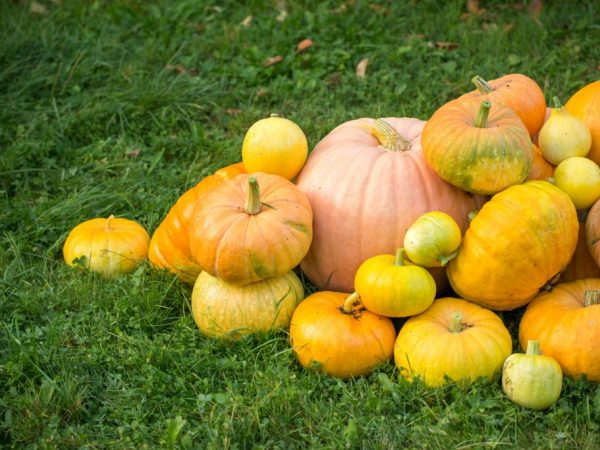
The most popular varieties of butternut squash
In which regions can you grow
Butternut squash prefers warm climates.
It is better to grow it outdoors in the South - there are the most suitable conditions for fruit ripening.
In other regions, the features of growing a plant are as follows:
- Moscow region and Leningrad region - the climate of these areas is characterized by a cold summer season and its short duration. It will be possible to grow a pumpkin only with the help of seedlings.
- Siberia and the Urals - frosts in this region last until June, so sowing directly into open ground is impossible. Seedlings are grown to receive them in early May. Planting is done in early summer using a compost heap.
Pumpkin varieties
The best varieties of butternut squash and their description are presented below.
Nectar
The plant is climbing. The length of the shoots is up to 3 m. The ripening period is 4 months.
Description of fruits:
- weight up to 6 kg;
- the surface is orange, ribbed;
- the seed nest is small;
- the pulp is bright orange, juicy, sweet;
- Has a pleasant aroma.
The use of pumpkin Nectar is universal. Mashed potatoes and juices are prepared from it.
Muscat de Agro variety
Description of fruits:
- weight 4 kg;
- round shape, flattened;
- the surface is divided into segments;
- the surface is red-orange;
- flesh with a pleasant crunch, sugary, dense, bright orange.
The late-ripening Muscat de Agro variety - ripens in 125-130 days. Climbing culture. Drought tolerant. Suitable for transportation.
Variety Chudo-Yudo
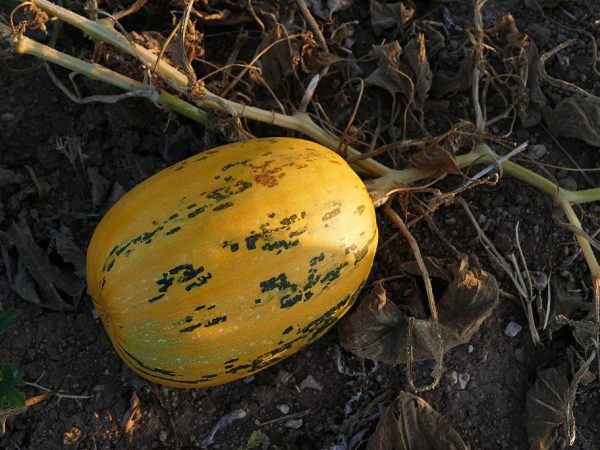
Chudo-Yudo pumpkin can be eaten raw
The plant is climbing. The leaves have 5 corners, solid, dark green. The growing season is 120 days.
The fruits are distinguished by the following qualities:
- have the shape of an oval;
- the surface is slightly segmented;
- weight 6-8 kg;
- orange peel with a green pattern and a grayish bloom;
- pulp is red-orange,
- the taste is memorable, pleasant.
The use is universal - the preparation of various dishes, juices, preserves. Chudo-Yudo pumpkin is also consumed fresh. Retains commercial qualities for a long time.
Prikubanskaya
Mid-season variety - fruits are harvested 90-130 days after mass germination. The yield is stable. The plant is medium-growing.
Prikubanskaya pumpkin fruits are characterized by the following qualities:
- they are aligned;
- cylindrical shape, thickened on one side;
- the surface is smooth, orange-brown;
- the pulp is red-orange, juicy and sweet;
- the seminal chamber is small.
Stores well - up to 3 months after harvest. Transfers transportation perfectly.
Arabat
Late ripening variety - 115-125 days. High-yielding, drought-resistant. It is immune to disease.
The Arabat pumpkin is large-fruited, the average weight is 6-8 kg, the length is up to 55 cm.
- cylindrical shape, elongated, thickened at the apex
- the peel is thin, yellow-orange;
- the pulp is rich orange, crispy, juicy and very sweet;
- nutmeg aroma;
- the seed nest is small.
Preservation of taste and marketability - 3-4 months. The fruits are baked, juices are prepared on their basis.
Pearl grade
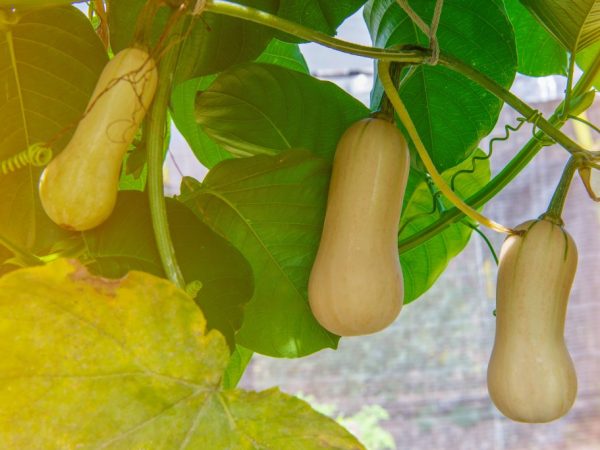
Pumpkins are used in cooking
Ripens in 115-125 days. Differs in powerful growth force, has 4-7 lashes. The leaves are small, solid, dark green, with light spots.
The fruits have an unusual shape - they are elongated, reminiscent of a nesting doll.
- the bark is bright orange, smooth, rarely slightly segmented, thin;
- average weight 4 kg, length up to 0.5 m;
- the pulp is dark orange, dense, juicy, sweet;
- the seminal chamber is small.
The pearl is used for culinary purposes. Its value is carotene in large quantities.
Variety Vitamin
The ripening period is 125-130 days. Yield indicators - 4 kg / m².
Culture of medium vigor. Forms shoots 6 m long. Leaves are 5-sided, green, with a gray tint and small light spots.
Description of fruits:
- oval shape;
- the surface is segmented, ribbed near the stalk;
- weight up to 7 kg, the fruit is short;
- the bark is thin, leathery, brown-brown with a green mesh;
- the pulp is bright orange, juicy, dense, thick, sweet;
- seed nest medium.
Vitamin butternut squash is rarely affected by powdery mildew. They are recommended for use in the recycling industry.
Provencal variety
Medium late view. Appointment canteen. The plant is climbing. Leaves are green, slightly dissected.
Fruit:
- rounded, flattened;
- the surface is divided into segments, it is orange-brown, with a bloom;
- weight 3-8 kg;
- the pulp is dark orange, medium juicy, contains a lot of carotene;
- seed nest medium.
Productivity - 4.2 kg / m². The variety is drought-resistant and tolerates transportation well. Dessert dishes, juices, smoothies are prepared from the fruits.
Variety Honey Princess
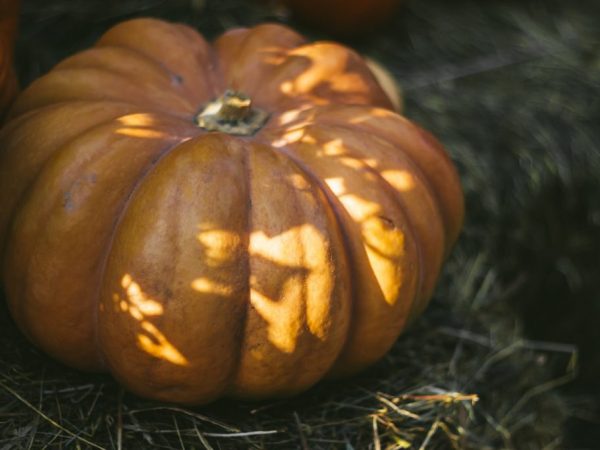
The fruits are delicious and sweet
The ripening period is 110-115 days. The yield indicators are high. Distinctive qualities of fruits:
- spherical shape, flattened;
- the surface is divided into segments, bright orange;
- weight 3-4 kg;
- the pulp is bright yellow, juicy, dense;
- the taste is honey-sweet.
Due to its low calorie content and high carotene content, the Honey Princess is used for baby and diet food. The variety is immune to the main diseases of pumpkin crops.
Muscat de provence
Ripening period - 115-120 days. The plant is powerful. The fruits are beautiful and even. Their description:
- spherical shape, flattened;
- the surface is orange-brown, segmented;
- weight 10 kg;
- the pulp is bright orange, high in sugar.
The variety practically does not affect the disease. Storage duration - up to six months. The commercial qualities are excellent. Seeds contain up to 45% fat.
Gilea
The growing season is 95-100 days. Productivity - 40 t / ha.
The plant is climbing, well leafy.
Fruit:
- round, slightly elongated;
- average weight - 6 kg;
- the surface is light brown with a waxy coating;
- the pulp is red-orange, dense, juicy, crispy and sweet.
The variety is not afraid of powdery mildew. Transportability is good. The fruits are stored for up to a year.
Polyanin
According to the description of the variety, the butternut squash Polyanin is transportable, well preserved, resistant to diseases and unfavorable environmental conditions.
Fruit:
- elongated shape;
- weight 4 kg;
- the surface is light brown, slightly ribbed;
- the peel is smooth, orange, glossy;
- the pulp is dense, juicy, sweet.
Russian woman
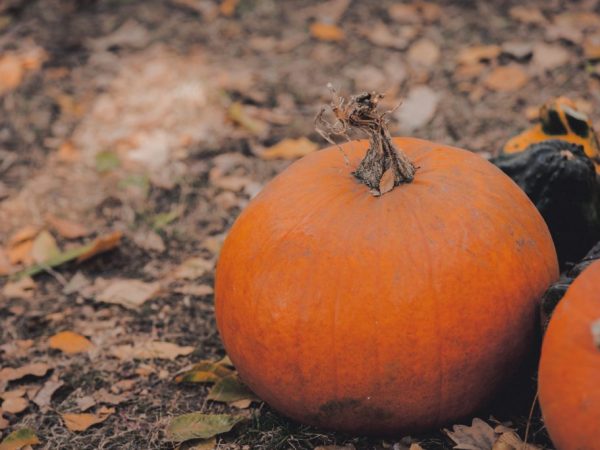
The variety Russian woman has a high yield.
Early ripe species - 90-110 days. The yield is high - 20 kg per plant. The culture is of medium vigor, climbing.
The fruits are distinguished by the following qualities:
- round shape;
- weight 2-4 kg;
- the peel is smooth, orange;
- the pulp is tender, juicy, bright orange, sweet;
- melon smell.
According to the description, this nutmeg variety is cold-resistant: pumpkin is suitable for cultivation in the Moscow region, in the Urals. The application is universal. Possesses a presentable look.
Michurinskaya
Ripening period - 95-105 days. The plant is climbing. The leaves are large, dark green.
The description of the fruits is as follows:
- flat-round shape;
- the surface is divided into segments, gray in color;
- weight up to 5 kg;
- the bark is thin, bending;
- the pulp is thick, juicy, sweetish;
- the smell is honey.
The appointment is dining. Pumpkin is eaten fresh and thermally processed. The culture tolerates adverse environmental conditions well, which makes it possible to grow it in Siberia and the Urals. The preservation is good. Long distance transportation is possible.
Spanish guitar
High-yielding variety - 6-10 kg / m².
The stems are short - up to 3 m. The fruits, looking rather unusual, resemble a guitar.
- elongated shape, thickened on one side;
- weight 2-4 kg, length up to 1 m;
- the surface is orange with green stripes;
- pulp is orange ooze orange-red, juicy, dense, sweet, occupies 90-95% of the fruit volume;
- fruity smell;
- tasting score - 4.9 points out of 5.
The harvest is stored for up to 120 days. Mashed potatoes and juices are prepared.
Butternut (Nut)
The variety is early ripening - ripening occurs 3 months after germination.
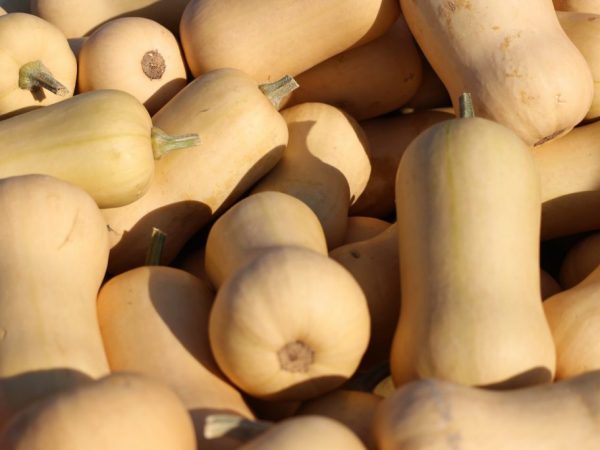
Nut gourd is suitable for diet food
Fruit:
- pear-shaped;
- the surface is yellow-orange;
- weight up to 1 kg;
- oily pulp, tender, juicy, sweet;
- aroma of nutmeg.
Hazelnut contains much fewer seeds than regular one. They are placed in the thickened part of the vegetable. The species has a long shelf life. Used for dietary and baby food.
Marble
Ripens late - 125-135 days. Recommended for cultivation in the South. Productivity - up to 4 kg / m².
Large-fruited pumpkin:
- round-flattened shape;
- weight 6-10 kg;
- the background is dark gray or green with light spots;
- the peel is soft;
- segmented surface;
- the pulp is juicy, tender, bright orange.
The harvest is stored for more than a year without loss of taste. The variety is resistant to white rot. Vegetables contain a lot of carotene.
Augustine
Ripening period - 105-110 days. The fruits have the following characteristics:
- the shape resembles a zucchini;
- the surface is dark green, smooth;
- weight 7-12 kg;
- the peel is thin, easy to clean;
- the pulp is bright orange, dense, crispy, sweet;
- the smell is light, refreshing.
The large-fruited pumpkin has a small seed nest.
Vita
The plant is medium-growing. The main shoot is long. Leaves are dark green with a gray spot, solid.
The fruits have the following description:
- round or slightly oval shape;
- the surface is slightly segmented or smooth, light brown with orange blotches;
- bark of medium thickness, leathery;
- the pulp is juicy, orange, dense, tasty.
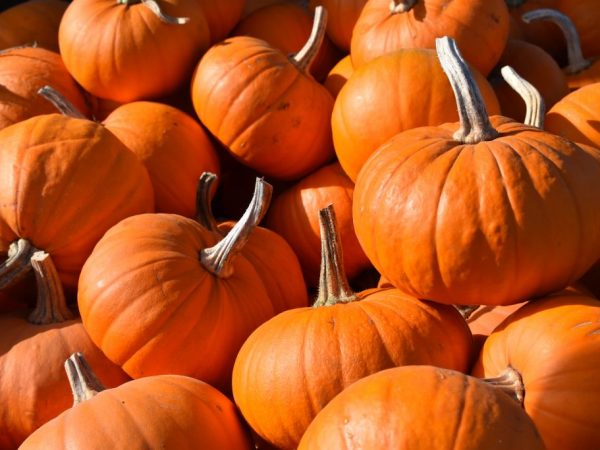
The fruits are juicy
The seed chamber is large. The seeds are small, creamy, smooth. The variety is used in cooking and agriculture as feed. It is affected by diseases of pumpkin crops.
Bylinka
The ripening period is average - 115-125 days. The fruits have the following characteristics:
- unusual shape - flat;
- the skin is sweaty, gray;
- average weight 4.5 kg;
- the pulp is bright orange, moderately sweet;
Pumpkin Bylinka has a nutmeg aroma and taste. It can be stored until next season. Does not require special care, resistant to external influences.
Family
Ripening later - 130-140 days. The plant is long-leaved.
The fruits are large, have the following description:
- cylindrical shape;
- length up to 1 m, weight up to 35 kg;
- the surface is dark green with a waxy coating;
- the pulp is orange, crispy, juicy;
- the seed nest is small.
The family pumpkin is used for making juices and soups.
Neapolitan giant
Butternut squash has the following characteristics:
- pear-shaped;
- the average weight is 15 kg, some specimens reach 35 kg;
- the surface is segmented, orange, with gray-green stripes at the top;
- the pulp is dark orange, occupies almost the entire volume of the vegetable.
The Neapolitan giant is eaten raw in salads. It is also used for making cereals, mashed potatoes, and pancakes.
Beauty
The growing season is 100-110 days. The plant is long-leaved. Leaves are 5-sided, solid, dark green.
Beauty pumpkin is consumed fresh and thermally processed.
Fruit:
- round shape;
- the surface is red-orange, segmented;
- weight 5-6 kg;
- the pulp is bright orange, juicy, tender.
Pineapple
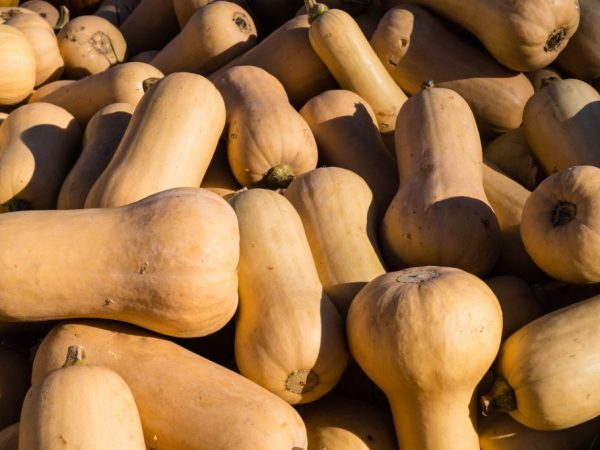
Fruits are stored for a long time
Mid-season hybrid - 110-125 days. The plant is of medium vigor, long-leaved. 5-6 fruits are formed on it, they have the following description:
- pear-shaped;
- the surface is smooth, beige and cream;
- weight 1.5-2.5 kg;
- the pulp is yellow-orange, juicy and dense;
- aroma of nutmeg.
The variety is immune to disease. The fruits are well kept.
Growing butternut squash
Soil preparation
Choose a spacious, lighted area, without drafts. Pumpkin prefers loamy and light soil. Other types of soil need to be improved.
The best predecessors are legumes, onions, cabbage, potatoes, and melons.
The garden bed is prepared in the fall: it is dug deeply and fertilized with rotted manure and superphosphate. In the spring, the actions are repeated, only ammonium nitrate is added.
Seed preparation
The purchased seed has already been treated with special substances. It is better to choose proven brands. For example, Agroni.
Semen preparation involves the following actions:
- soaking in hot water 50˚С for several hours;
- wrapping in a damp cloth until they hatch;
- room on the bottom shelf of the refrigerator.
Reproduction
Better to grow seedlings. Sowing dates are the end of April. They are corrected, focusing on the climate of the region.
Take containers with a diameter of at least 10 cm, cover them with soil, half mixed with humus. 2 seeds are placed in each, with the sharp tip down. The vessels are placed in a warm place - 22-25˚С. After the emergence of seedlings, the temperature is gradually reduced to 18-20˚С. Over time, one sprout is removed, leaving a stronger one.
Seedling care involves the following actions:
- watering - as needed;
- top dressing - twice with complex fertilizer.
Before planting, the plants are hardened. They are planted in open ground when 3-4 leaves appear.
Landing
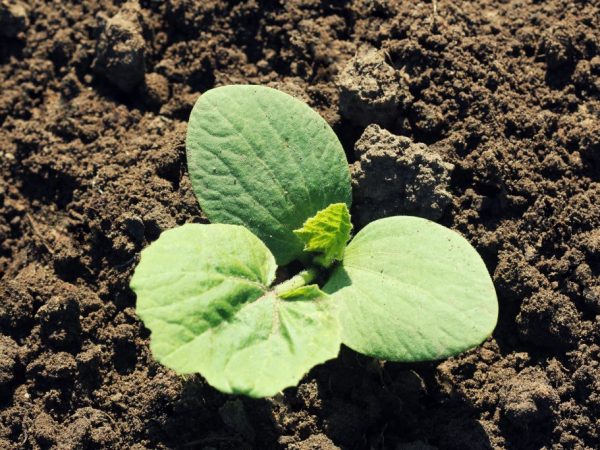
Seedlings are planted in warm ground
Approximate landing time is late May - early June. The earth should warm up to 12˚С.
The distance between seedlings should be at least 0.6 m, but, depending on the selected variety, it can be increased.
First, make holes 10 cm deep. Water each one. Plants are planted.
Care
Weeding
Until the plants adapt and begin to actively develop, it is worth carefully removing the weeds. It will stop growing when the crop forms shoots and the leaves take up a large area.
The soil needs to be loosened. In the aisles - to a greater depth, under the plants - to a lesser depth.
Watering
Although many species are drought tolerant, it is worthwhile to take responsibility for soil moisture.
Watering rules:
- before tying the ovaries - once a week;
- after this period - once every 1-2 weeks.
The water is taken in a settled and warm water - 20˚С. Humidification with cold water will spread disease. After each procedure, the soil is loosened.
Watering is stopped two weeks before harvesting.
Top dressing
Plants are fertilized in 2 stages:
- 10 days after planting: the mullein infusion is diluted with water (1:10).10 g of superphosphate are also added.
- During flowering - complex fertilizer, potassium sulfate, wood ash are suitable.
Pollination
If the weather is bad and there are no insects that pollinate the plants, it is worth doing the process yourself. Do this in the morning when it is cool.
- Take a male flower;
- Remove leaves from it;
- The stigma of a female flower is touched with a stamen.
The pollen can be transferred with a soft brush. It is worth making sure that it is not crumpled. You can distinguish flowers if you look closely at them. In females, a thickening is located at the end of the peduncle - the future fetus.
Formation
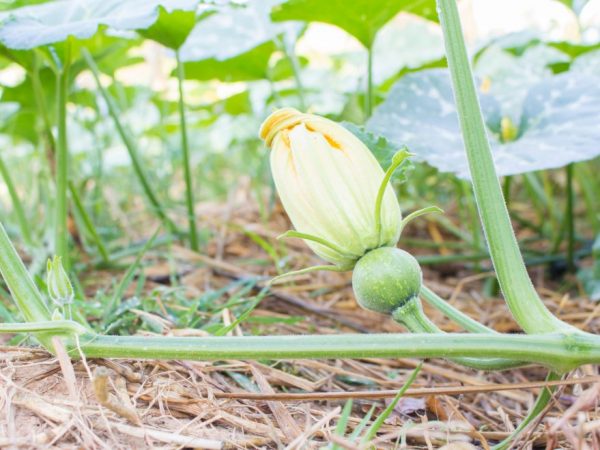
Shaping will help you get a good harvest
The plant forms many ovaries, but is unable to provide them with the necessary nutrition. So that the crop is not small, you need to leave 2-3 fruits on it.
The formation also provides for the implementation of such recommendations:
- pinch the stems at a distance of 0.5 m from the ovary;
- remove excess shoots;
- spread the lashes and sprinkle with earth in several places.
Then the plant forms new roots. This will provide him with additional food.
Harvesting and storage
It is advisable to remove the fruits before the onset of cold weather. For many species, even a slight drop in temperature will cause irreparable harm.
Fruit picking rules:
- perform the procedure with pruning shears in dry weather;
- leave part of the stalk - 3-4 cm;
- perform actions carefully so as not to damage the peel.
The crop can be stored at room temperature, but the optimal performance is 12 ° C. Butternut squash is often placed in a dark place for 2 months. It is believed that it will become more tasty and aromatic, and the skin will become firm with a clear pattern.
Pests and diseases
Diseases
Common diseases of butternut squash and measures to combat them:
- Bacteriosis - dark green spots appear on the leaves, on the back of them there is an oily substance. Over time, the leaf plate dries up. The disease also damages the fruit - they are deformed. For treatment, use Bordeaux mixture or copper sulfate. The affected parts of the plant are destroyed.
- Anthracnose - leaves cover brown spots. Over time, they begin to crumble, holes appear. The leaf plates dry up. The disease affects the fruits and stems of the crop. They fight it with Bordeaux liquid and copper oxychloride.
- Root rot - first affects the underground part of the plant. The roots turn brown, flabby and crack. Leaves turn yellow, pumpkin growth stops. Treat the disease with drugs Previkur, Fundazol. The plant is sprinkled with wood ash.
- Powdery mildew - small white spots appear on the leaves. Over time, they cover the leaf plates completely in the form of a plaque. The fruits are deformed, the plants dry up. The following medicinal substances are used: calloidal sulfur, sodium phosphate.
- Spotted mosaic - small yellow and green spots appear on the leaves, which alternate. Culture slows down its growth. You need to process it with Pharmayod-3.
Pests
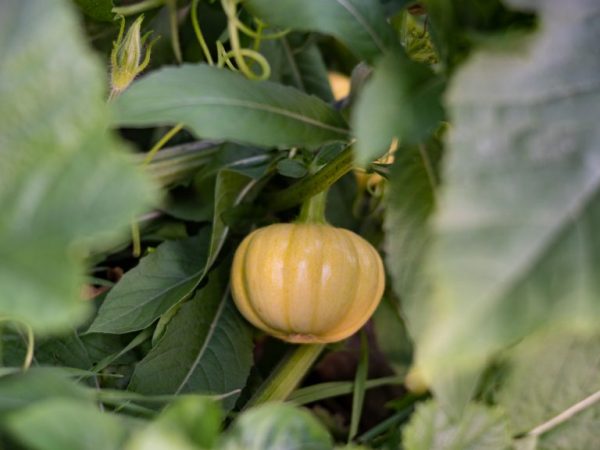
Inspect the plant regularly for insects
According to the characteristics, the following insects can affect the nutmeg gourd:
- Spider mite - sucks sap from plants. It can be seen on the back of the leaves, and a light cobweb also appears. To combat the pest, use Karbofos, an infusion of onion peel.
- Melon aphid - colonies of insects settle at the bottom of the leaves, trying to sap them. Over time, the plant dries up. The culture is treated with infusions of wormwood, celandine, onion peel. With a strong defeat - Karbofos, Tryfos.
- Slugs - eat young leaves and sprouts. Plants are sprinkled with ash, sprinkled with infusions of wormwood, garlic. The drug Groza is also used.
Prophylaxis
Preventive measures consist in the implementation of the following recommendations:
- compliance with crop rotation;
- applying the correct disembarkation scheme;
- removal of plant residues from the site in the fall;
- weed control;
- compliance with the irrigation regime;
- regular inspection of plants;
- planting a number of crops that do not have the same diseases as pumpkin.
Reviews of gardeners
People who are engaged in the cultivation of nutmeg pumpkin in their area are advised to plant the culture in a seedling way. Planting the seed directly into the open ground is possible if the region has a warm and long summer.
Gardeners highlight many advantages:
- high productivity;
- early or medium ripening;
- rapid bud formation;
- long fruiting period;
- high taste characteristics.
Housewives are pleased with the universal use of fruits. Some types are added to salads raw, porridge, mashed potatoes, soups are also prepared. Eaten steamed and baked.
Muscat varieties are high in sugar and carotene. Healthy not only pulp, but also seeds. They are often taken to prevent helminthiasis.

